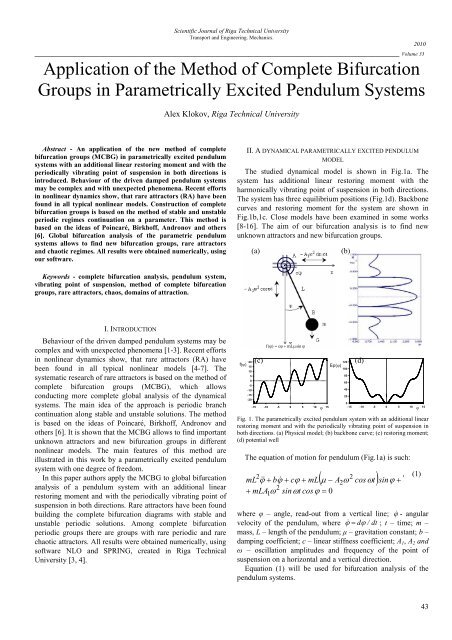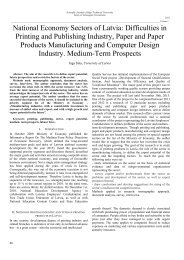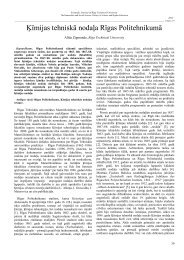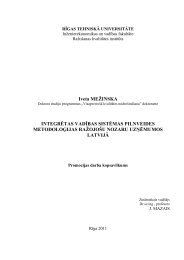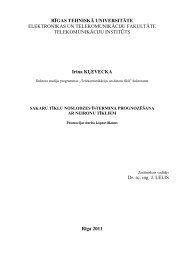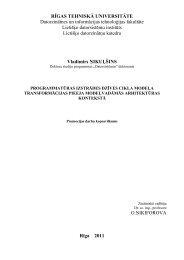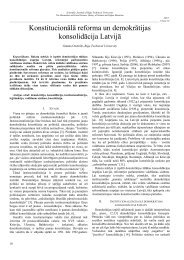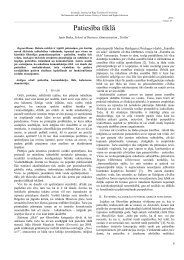Application of the Method of Complete Bifurcation Groups in ... - ortus
Application of the Method of Complete Bifurcation Groups in ... - ortus
Application of the Method of Complete Bifurcation Groups in ... - ortus
Create successful ePaper yourself
Turn your PDF publications into a flip-book with our unique Google optimized e-Paper software.
Scientific Journal <strong>of</strong> Riga Technical University<br />
Transport and Eng<strong>in</strong>eer<strong>in</strong>g. Mechanics.<br />
________________________________________________________________________________ Volume 33<br />
<strong>Application</strong> <strong>of</strong> <strong>the</strong> <strong>Method</strong> <strong>of</strong> <strong>Complete</strong> <strong>Bifurcation</strong><br />
<strong>Groups</strong> <strong>in</strong> Parametrically Excited Pendulum Systems<br />
Abstract - An application <strong>of</strong> <strong>the</strong> new method <strong>of</strong> complete<br />
bifurcation groups (MCBG) <strong>in</strong> parametrically excited pendulum<br />
systems with an additional l<strong>in</strong>ear restor<strong>in</strong>g moment and with <strong>the</strong><br />
periodically vibrat<strong>in</strong>g po<strong>in</strong>t <strong>of</strong> suspension <strong>in</strong> both directions is<br />
<strong>in</strong>troduced. Behaviour <strong>of</strong> <strong>the</strong> driven damped pendulum systems<br />
may be complex and with unexpected phenomena. Recent efforts<br />
<strong>in</strong> nonl<strong>in</strong>ear dynamics show, that rare attractors (RA) have been<br />
found <strong>in</strong> all typical nonl<strong>in</strong>ear models. Construction <strong>of</strong> complete<br />
bifurcation groups is based on <strong>the</strong> method <strong>of</strong> stable and unstable<br />
periodic regimes cont<strong>in</strong>uation on a parameter. This method is<br />
based on <strong>the</strong> ideas <strong>of</strong> Po<strong>in</strong>caré, Birkh<strong>of</strong>f, Andronov and o<strong>the</strong>rs<br />
[6]. Global bifurcation analysis <strong>of</strong> <strong>the</strong> parametric pendulum<br />
systems allows to f<strong>in</strong>d new bifurcation groups, rare attractors<br />
and chaotic regimes. All results were obta<strong>in</strong>ed numerically, us<strong>in</strong>g<br />
our s<strong>of</strong>tware.<br />
Keywords - complete bifurcation analysis, pendulum system,<br />
vibrat<strong>in</strong>g po<strong>in</strong>t <strong>of</strong> suspension, method <strong>of</strong> complete bifurcation<br />
groups, rare attractors, chaos, doma<strong>in</strong>s <strong>of</strong> attraction.<br />
I. INTRODUCTION<br />
Behaviour <strong>of</strong> <strong>the</strong> driven damped pendulum systems may be<br />
complex and with unexpected phenomena [1-3]. Recent efforts<br />
<strong>in</strong> nonl<strong>in</strong>ear dynamics show, that rare attractors (RA) have<br />
been found <strong>in</strong> all typical nonl<strong>in</strong>ear models [4-7]. The<br />
systematic research <strong>of</strong> rare attractors is based on <strong>the</strong> method <strong>of</strong><br />
complete bifurcation groups (MCBG), which allows<br />
conduct<strong>in</strong>g more complete global analysis <strong>of</strong> <strong>the</strong> dynamical<br />
systems. The ma<strong>in</strong> idea <strong>of</strong> <strong>the</strong> approach is periodic branch<br />
cont<strong>in</strong>uation along stable and unstable solutions. The method<br />
is based on <strong>the</strong> ideas <strong>of</strong> Po<strong>in</strong>caré, Birkh<strong>of</strong>f, Andronov and<br />
o<strong>the</strong>rs [6]. It is shown that <strong>the</strong> MCBG allows to f<strong>in</strong>d important<br />
unknown attractors and new bifurcation groups <strong>in</strong> different<br />
nonl<strong>in</strong>ear models. The ma<strong>in</strong> features <strong>of</strong> this method are<br />
illustrated <strong>in</strong> this work by a parametrically excited pendulum<br />
system with one degree <strong>of</strong> freedom.<br />
In this paper authors apply <strong>the</strong> MCBG to global bifurcation<br />
analysis <strong>of</strong> a pendulum system with an additional l<strong>in</strong>ear<br />
restor<strong>in</strong>g moment and with <strong>the</strong> periodically vibrat<strong>in</strong>g po<strong>in</strong>t <strong>of</strong><br />
suspension <strong>in</strong> both directions. Rare attractors have been found<br />
build<strong>in</strong>g <strong>the</strong> complete bifurcation diagrams with stable and<br />
unstable periodic solutions. Among complete bifurcation<br />
periodic groups <strong>the</strong>re are groups with rare periodic and rare<br />
chaotic attractors. All results were obta<strong>in</strong>ed numerically, us<strong>in</strong>g<br />
s<strong>of</strong>tware NLO and SPRING, created <strong>in</strong> Riga Technical<br />
University [3, 4].<br />
Alex Klokov, Riga Technical University<br />
II. A DYNAMICAL PARAMETRICALLY EXCITED PENDULUM<br />
MODEL<br />
2010<br />
The studied dynamical model is shown <strong>in</strong> Fig.1a. The<br />
system has additional l<strong>in</strong>ear restor<strong>in</strong>g moment with <strong>the</strong><br />
harmonically vibrat<strong>in</strong>g po<strong>in</strong>t <strong>of</strong> suspension <strong>in</strong> both directions.<br />
The system has three equilibrium positions (Fig.1d). Backbone<br />
curves and restor<strong>in</strong>g moment for <strong>the</strong> system are shown <strong>in</strong><br />
Fig.1b,1c. Close models have been exam<strong>in</strong>ed <strong>in</strong> some works<br />
[8-16]. The aim <strong>of</strong> our bifurcation analysis is to f<strong>in</strong>d new<br />
unknown attractors and new bifurcation groups.<br />
f(ϕ)<br />
20 (c) 120 (d)<br />
15<br />
Ep(ϕ)<br />
100<br />
10<br />
5<br />
80<br />
0<br />
-5<br />
-10<br />
-15<br />
-20<br />
(a) (b)<br />
f<br />
( ϕ) = cϕ<br />
+ mLµ<br />
s<strong>in</strong> ϕ<br />
-15 -10 -5 0 5 10 ϕ 15<br />
60<br />
40<br />
20<br />
0<br />
-15 -10 -5 0 5 10 15<br />
Fig. 1. The parametrically excited pendulum system with an additional l<strong>in</strong>ear<br />
restor<strong>in</strong>g moment and with <strong>the</strong> periodically vibrat<strong>in</strong>g po<strong>in</strong>t <strong>of</strong> suspension <strong>in</strong><br />
both directions. (a) Physical model; (b) backbone curve; (c) restor<strong>in</strong>g moment;<br />
(d) potential well<br />
The equation <strong>of</strong> motion for pendulum (Fig.1a) is such:<br />
2<br />
mL & ϕ&<br />
+ b & ϕ + cϕ<br />
+ mL<br />
2<br />
+ mLA1ω<br />
s<strong>in</strong>ωt<br />
cosϕ<br />
= 0<br />
2 ( µ − A ω cosωt<br />
)<br />
2<br />
ϕ<br />
, (1)<br />
s<strong>in</strong>ϕ<br />
+<br />
where φ – angle, read-out from a vertical l<strong>in</strong>e; ϕ& - angular<br />
velocity <strong>of</strong> <strong>the</strong> pendulum, where & ϕ = dϕ / dt ; t – time; m –<br />
mass, L – length <strong>of</strong> <strong>the</strong> pendulum; µ – gravitation constant; b –<br />
damp<strong>in</strong>g coefficient; с – l<strong>in</strong>ear stiffness coefficient; А1, А2 and<br />
ω – oscillation amplitudes and frequency <strong>of</strong> <strong>the</strong> po<strong>in</strong>t <strong>of</strong><br />
suspension on a horizontal and a vertical direction.<br />
Equation (1) will be used for bifurcation analysis <strong>of</strong> <strong>the</strong><br />
pendulum systems.<br />
43
Scientific Journal <strong>of</strong> Riga Technical University<br />
Transport and Eng<strong>in</strong>eer<strong>in</strong>g. Mechanics.<br />
________________________________________________________________________________ Volume 33<br />
III. RESULTS<br />
The results <strong>of</strong> bifurcation analysis <strong>of</strong> <strong>the</strong> model (1) are<br />
represented <strong>in</strong> Fig. 2-15. In <strong>the</strong> first special case <strong>the</strong> model<br />
only with horizontal external force has three simple 1T<br />
bifurcation groups (Fig. 2).<br />
44<br />
(c)<br />
P1 1 left<br />
(a) А1 = var., А2 = 0<br />
(b)<br />
А1 = 0.5<br />
Fig. 2. Parametrically excited pendulum system (see Fig. 1a) with l<strong>in</strong>ear<br />
restor<strong>in</strong>g moment and with <strong>the</strong> periodically vibrat<strong>in</strong>g po<strong>in</strong>t <strong>of</strong> suspension <strong>in</strong><br />
horizontal direction. (a), (b) <strong>Bifurcation</strong> diagrams: state (φ, Amplitude) <strong>of</strong> <strong>the</strong><br />
fixed periodic po<strong>in</strong>ts versus horizontal external force amplitude A1. There are<br />
three simple 1T bifurcation groups. (c), (d), (e) Phase projections for crosssection<br />
A1 = 0.5. Parameters: m =1, L = 1, b = 0.2, c = 1, µ = 9.81, ω = 1.5,<br />
A1 = var., A2 = 0<br />
(a)<br />
P11 right<br />
P1 2<br />
А1 = var., А2 = 0<br />
P11<br />
P1 1 right<br />
Fig. 3. Parametrically excited pendulum system (see Fig. 1a) with l<strong>in</strong>ear<br />
restor<strong>in</strong>g moment and with <strong>the</strong> periodically vibrat<strong>in</strong>g po<strong>in</strong>t <strong>of</strong> suspension <strong>in</strong><br />
horizontal direction. (a) Dynamical wells on <strong>the</strong> Po<strong>in</strong>caré map built by Lm(-<br />
10, -0.1; 10,-0.1) 201Q×250T. (b) Attractor-bas<strong>in</strong> phase portrait with 501×501<br />
grid <strong>of</strong> <strong>in</strong>itial conditions for Eq.(1) <strong>of</strong> Fig. 2a. Parameters: m=1, L = 1, b =<br />
0.2, c = 1, µ = 9.81, ω = 1.5, A1 = 0.5, A2 = 0<br />
Phase projections for cross-section A1 = 0.5 are shown <strong>in</strong><br />
Fig. 2c, 2d, 2e. Dynamical wells built by L<strong>in</strong>e mapp<strong>in</strong>g from a<br />
P12<br />
P1 2<br />
(d) (e)<br />
А1 = 0.5<br />
(b)<br />
А1 = 0.5<br />
P1 1 left<br />
2010<br />
l<strong>in</strong>e (-10,-0.1; 10,-0.1) on <strong>the</strong> Po<strong>in</strong>caré map are represented on<br />
Fig. 3a. Us<strong>in</strong>g Cell-to-Cell mapp<strong>in</strong>g with 501×501 grid <strong>of</strong><br />
<strong>in</strong>itial conditions, doma<strong>in</strong>s <strong>of</strong> attraction (Fig. 3b) have been<br />
obta<strong>in</strong>ed for cross-section A1 = 0.5 (see Fig. 2a).<br />
(a)<br />
(b)<br />
Fig. 4. Parametrically excited pendulum system (see Fig. 1a) with l<strong>in</strong>ear<br />
restor<strong>in</strong>g moment and with <strong>the</strong> periodically vibrat<strong>in</strong>g po<strong>in</strong>t <strong>of</strong> suspension <strong>in</strong><br />
vertical direction. (a), (b) <strong>Bifurcation</strong> diagrams: state (φ, Amplitude) <strong>of</strong> <strong>the</strong><br />
fixed periodic po<strong>in</strong>ts versus vertical external force amplitude A2. There are<br />
three symmetric 1T and one 2T bifurcation groups. Parameters: m = 1, L= 1, b<br />
= 0.2, c = 1, µ = 9.81, ω = 1.5, A1 = 0, A2 = var.<br />
In <strong>the</strong> second special case <strong>the</strong> model only with vertical<br />
external force have three symmetric 1T and one 2T bifurcation<br />
groups (Fig. 4). In this figure stable solutions are plotted by<br />
solid l<strong>in</strong>es and unstable – by th<strong>in</strong> l<strong>in</strong>es (reddish onl<strong>in</strong>e). In Fig.<br />
5 coexistence <strong>of</strong> P11 tw<strong>in</strong>s stable solutions and P11 RA tw<strong>in</strong>s<br />
rare attractors (see Fig. 4) <strong>in</strong> cross-section А2 = 0.4882 is<br />
shown. Doma<strong>in</strong>s <strong>of</strong> attractions obta<strong>in</strong>ed us<strong>in</strong>g two different<br />
methods are shown <strong>in</strong> Fig. 6: (a) <strong>in</strong>sets and outsets from two<br />
symmetric 1T saddles; (b) Cell-to-Cell mapp<strong>in</strong>g with 501×501<br />
grid <strong>of</strong> <strong>in</strong>itial conditions.<br />
(a)<br />
Fig. 5. Coexistence <strong>of</strong> P11 tw<strong>in</strong>s stable solutions and P11 RA tw<strong>in</strong>s rare<br />
attractors (see Fig. 4) <strong>in</strong> cross-section А2 = 0.4882. (а) Time histories, (b)<br />
phase projections. Parameters: m = 1, L = 1, b = 0.2, c = 1, µ = 9.81, ω = 1.5,<br />
A1 = 0, A2 = 0.4882<br />
(b)
Scientific Journal <strong>of</strong> Riga Technical University<br />
Transport and Eng<strong>in</strong>eer<strong>in</strong>g. Mechanics.<br />
________________________________________________________________________________ Volume 33<br />
(a) (b)<br />
Fig. 6. Parametrically excited pendulum system (see Fig. 1a) with l<strong>in</strong>ear<br />
restor<strong>in</strong>g moment and with <strong>the</strong> periodically vibrat<strong>in</strong>g po<strong>in</strong>t <strong>of</strong> suspension <strong>in</strong><br />
vertical direction. (a) Insets and outsets from two symmetric 1T saddles<br />
(±0.586055, ±0.516811; ρ1 = 1.112, ρ2 = 0.389). (b) Attractor-bas<strong>in</strong> phase<br />
portrait with 501×501 grid <strong>of</strong> <strong>in</strong>itial conditions for Eq.(1) <strong>of</strong> Fig. 4a.<br />
Parameters: m=1, L = 1, b = 0.2, c = 1, µ = 9.81, ω = 1.5, A1 = 0, A2 = 4.1<br />
Five different 1T bifurcation groups and one 2T bifurcation<br />
group have been found (Fig. 7) <strong>in</strong> general case for<br />
parametrically excited pendulum system with l<strong>in</strong>ear restor<strong>in</strong>g<br />
moment and with <strong>the</strong> periodically vibrat<strong>in</strong>g po<strong>in</strong>t <strong>of</strong><br />
suspension <strong>in</strong> both directions. Two <strong>of</strong> <strong>the</strong>se groups are<br />
topologically similar and have rare attractors <strong>of</strong> a tip k<strong>in</strong>d Р11<br />
RA and Р13 RA. Two period one brunches near A2 = 4 are not<br />
completed, because <strong>of</strong> problems <strong>of</strong> s<strong>in</strong>gularity. O<strong>the</strong>r three 1T<br />
bifurcation groups have <strong>the</strong> own rare attractors P14 RA and<br />
P15 RA, which are stable <strong>in</strong> small parameter regions. Some<br />
cross-sections (A2 = const) <strong>of</strong> bifurcation diagrams with<br />
dynamical characteristics from Fig. 7 are represented <strong>in</strong> Fig. 8,<br />
9, 13, 14, 15. All attractors are <strong>of</strong> tip k<strong>in</strong>d so each <strong>of</strong> <strong>the</strong>m has<br />
not only periodic attractors, but also chaotic attractors as well.<br />
(a)<br />
(b)<br />
Fig. 7. The parametrically excited pendulum system (Eq. 1) with l<strong>in</strong>ear<br />
restor<strong>in</strong>g moment and with <strong>the</strong> periodically vibrat<strong>in</strong>g po<strong>in</strong>t <strong>of</strong> suspension <strong>in</strong><br />
both directions. (a), (b) <strong>Bifurcation</strong> diagrams: state (φ, Amplitude) <strong>of</strong> <strong>the</strong> fixed<br />
periodic po<strong>in</strong>ts versus vertical external force amplitude A2. There are five 1T<br />
and one 2T bifurcation groups. Parameters: m = 1, L = 1, b = 0.2, c = 1, µ =<br />
9.81, ω = 1.5, A1 = 0.5, A2 = var.<br />
(а)<br />
(b)<br />
(c)<br />
2010<br />
Fig. 8. Coexistence <strong>of</strong> P1 usual and rare attractors P1 RA for three crosssections<br />
(see Fig. 7). (а) Time histories and phase projections for A2 = 0.44.<br />
The rare attractor P13 RA has <strong>the</strong> fixed po<strong>in</strong>t FP (-4.05606 /1.17632). (b) The<br />
same for А2 = 0.526. Rare attractor P11 RA has <strong>the</strong> FP (4.56968/-2.60245).<br />
(c) The same for А2 = 3.44. Rare attractor P11 tip RA has <strong>the</strong> FP (5.23616/-<br />
0.315143). Parameters: m = 1, L = 1, b = 0.2, c = 1, µ = 9.81, ω = 1.5, A1 =<br />
0.5, A2 = var.<br />
The examples <strong>of</strong> coexistence <strong>of</strong> period-1 (P1) stable<br />
solutions and P1 RA rare attractors for three cross-sections A2<br />
= 0.44, A2 = 0.526 and A2 = 3.44 on bifurcation diagram (Fig.<br />
7a) with <strong>the</strong> time histories and phases projections are shown <strong>in</strong><br />
Fig. 8. Oscillation amplitudes <strong>of</strong> rare attractors <strong>in</strong> some cases<br />
are tenfold bigger than oscillat<strong>in</strong>g amplitudes <strong>of</strong> stable P1<br />
regimes. The exam<strong>in</strong>ed system has also o<strong>the</strong>r bifurcation<br />
group <strong>of</strong> higher order with rare attractors, for example, 2T<br />
bifurcation group with P2 RA rare attractor with large<br />
oscillation amplitudes.<br />
Each bifurcation group has its own unstable periodic<br />
<strong>in</strong>f<strong>in</strong>itium (UPI) [4-7] with correspond<strong>in</strong>g chaotic attractors.<br />
The example <strong>of</strong> globally stable chaotic attractor for crosssection<br />
with parameters А1 = 0.5, А2 = 4.9, obta<strong>in</strong>ed us<strong>in</strong>g <strong>the</strong><br />
contour mapp<strong>in</strong>g [4-7], is shown <strong>in</strong> Fig. 9. The system also<br />
has o<strong>the</strong>r nT subharmonic bifurcation groups with n = 3, not<br />
shown.<br />
(a) (а) Cm 4×250Q×1000T<br />
(b)<br />
А1 = 0.5, А2 = 4.9<br />
NT = (250-1000)T<br />
СhA-12<br />
x0 = 0.36,<br />
v0 = 0.0<br />
А1 = 0.5, А2 = 4.9<br />
NT = 30T<br />
Fig. 9. Chaotic attractor <strong>in</strong> <strong>the</strong> parametrically excited pendulum system for<br />
cross-section А2 = 4.9 <strong>of</strong> bifurcation diagram Fig. 7: (а) Po<strong>in</strong>caré map - Cm<br />
4×250Q×(250-1000)T; (b) phase projection with NT=30T. Parameters: m = 1,<br />
L = 1, b = 0.2, c = 1, µ=9.81, ω = 1.5, A1 = 0.5, A2 = 4.9<br />
45
Scientific Journal <strong>of</strong> Riga Technical University<br />
Transport and Eng<strong>in</strong>eer<strong>in</strong>g. Mechanics.<br />
________________________________________________________________________________ Volume 33<br />
Fig. 10. The parametrically excited pendulum system (Eq. 1) with l<strong>in</strong>ear<br />
restor<strong>in</strong>g moment and with <strong>the</strong> periodically vibrat<strong>in</strong>g po<strong>in</strong>t <strong>of</strong> suspension <strong>in</strong><br />
both directions. <strong>Bifurcation</strong> diagram - state (Amplitude) <strong>of</strong> <strong>the</strong> fixed periodic<br />
po<strong>in</strong>ts versus horizontal external force amplitude A1. There are three 1T and<br />
one 6T bifurcation groups. Parameters: m = 1, L = 1, b = 0.2, c= 1, µ = 9.81, ω<br />
= 1.5, A1 = var., A2 = 1<br />
Fig. 11. Phase projections for coexist<strong>in</strong>g periodic regimes P11, P12 and ChA-<br />
13 chaotic attractor for cross-section А1 = 3.95 (see Fig.10). Parameters: m =<br />
1, L = 1, b = 0.2, c = 1, µ = 9.81, ω = 1.5, A1 = 3.95, A2 = 1<br />
Coexistence <strong>of</strong> Р1 stable solutions and ChA-13 chaotic<br />
attractor is shown on phase projections (Fig. 11) and on<br />
Fig. 12. Coexistence <strong>of</strong> Р1 stable solutions and ChA-13 chaotic attractor for<br />
cross-section А1 = 3.95 <strong>in</strong> <strong>the</strong> parametrically excited pendulum system with<br />
additional l<strong>in</strong>ear restor<strong>in</strong>g moment (see Fig. 10): a) Po<strong>in</strong>caré map - Cm<br />
4×250Q×1000T; b) fragment <strong>of</strong> contour mapp<strong>in</strong>g. Parameters: m = 1, L = 1, b<br />
= 0.2, c = 1, µ = 9.81, ω = 1.5, A1 = 3.95, A2 = 1<br />
46<br />
(а) А1 = 0.5, А2 = 0 (b)<br />
(c)<br />
P13<br />
P13<br />
(e) А1 = 0.5, А2 = 0.526 (f)<br />
P13<br />
P12<br />
P13 RA<br />
P11<br />
А1 = 0.5, А2 = 0.44<br />
P12<br />
P12<br />
P11 RA<br />
P11<br />
P11<br />
(d)<br />
P13<br />
P13<br />
P13<br />
P12<br />
P12<br />
2010<br />
А1 = 0.5, А2 = 0.4<br />
P11<br />
А1 = 0.5, А2 = 0.5<br />
P11<br />
А1 = 0.5, А2 = 1.7<br />
Fig. 13. Attractor-bas<strong>in</strong> phase portraits with 501×501 grid <strong>of</strong> <strong>in</strong>itial conditions<br />
for Eq.(1) <strong>of</strong> Fig. 7a. Parameters: m = 1, L = 1, b = 0.2, c = 1, µ = 9.81, ω =<br />
1.5, A1 = 0.5, A2 = var.<br />
Po<strong>in</strong>caré map - Cm 4×250Q×1000T (Fig. 12).At cross-section<br />
А1 = 3.95 <strong>of</strong> bifurcation diagram (see Fig. 10) <strong>in</strong> <strong>the</strong><br />
parametrically excited pendulum system with additional l<strong>in</strong>ear<br />
restor<strong>in</strong>g moment and vibrat<strong>in</strong>g po<strong>in</strong>t <strong>of</strong> suspension <strong>in</strong> both<br />
directions <strong>the</strong>re are periodic regimes P11, P12 and chaotic<br />
attractor ChA-13. Doma<strong>in</strong>s <strong>of</strong> attraction <strong>of</strong> periodic solutions<br />
<strong>in</strong> parametrically excited pendulum system for different crosssections<br />
<strong>of</strong> bifurcation diagram (see Fig. 7) obta<strong>in</strong>ed by Cell-<br />
(g) (h)<br />
(i)<br />
P23 RA<br />
P120<br />
А1 = 0.5, А2 = 1.7112<br />
(j)<br />
P12<br />
P11<br />
А1 = 0.5, А2 = 2.37<br />
А1 = 0.5, А2 = 3.44 А1 = 0.5, А2 = 3.5<br />
P121<br />
P11<br />
P13 P12 P12 P11<br />
P11 tip RA<br />
Fig. 14. Attractor-bas<strong>in</strong> phase portraits with 501×501 grid <strong>of</strong> <strong>in</strong>itial conditions<br />
for Eq.(1) <strong>of</strong> Fig. 7a. Parameters: m = 1, L = 1, b = 0.2, c = 1, µ = 9.81, ω =<br />
1.5, A1 = 0.5, A2 = var.<br />
P23<br />
P120<br />
P121
Scientific Journal <strong>of</strong> Riga Technical University<br />
Transport and Eng<strong>in</strong>eer<strong>in</strong>g. Mechanics.<br />
________________________________________________________________________________ Volume 33<br />
(a)<br />
(b)<br />
А1 = 0.5, А2 = 3.44<br />
P1 1 tip RA<br />
Fig. 15. Doma<strong>in</strong>s <strong>of</strong> attraction <strong>of</strong> period-1 tip rare attractor P11 tip RA (see<br />
Fig. 7a and 14i) <strong>in</strong> a parametrically excited pendulum system: (a) obta<strong>in</strong>ed by<br />
us<strong>in</strong>g a reverse contour mapp<strong>in</strong>g from a rectangle; (b) obta<strong>in</strong>ed by us<strong>in</strong>g Cellto-Cell<br />
mapp<strong>in</strong>g with 501×501 grid <strong>of</strong> <strong>in</strong>itial conditions. Parameters: m = 1,<br />
L= 1, b = 0.2, c = 1, µ = 9.81, ω = 1.5, A1 = 0.5, A2 = 3.44<br />
-to-Cell mapp<strong>in</strong>g, are shown <strong>in</strong> Fig. 13-14.Comparison <strong>of</strong> two<br />
different methods for build<strong>in</strong>g doma<strong>in</strong>s <strong>of</strong> attraction <strong>of</strong> tip<br />
k<strong>in</strong>d rare attractor P11 RA is represented <strong>in</strong> Fig. 15: (a) reverse<br />
contour mapp<strong>in</strong>g from a rectangle; (b) Cell-to-Cell mapp<strong>in</strong>g<br />
with 501×501 grid <strong>of</strong> <strong>in</strong>itial conditions. These methods show<br />
<strong>the</strong> same results <strong>of</strong> build<strong>in</strong>g doma<strong>in</strong>s <strong>of</strong> attraction.<br />
IV. CONCLUSIONS<br />
It is shown that us<strong>in</strong>g <strong>of</strong> <strong>the</strong> method <strong>of</strong> complete bifurcation<br />
groups allows to conduct <strong>the</strong> bifurcation analysis <strong>of</strong> a<br />
parametrically excited pendulum systems with additional<br />
l<strong>in</strong>ear, and to f<strong>in</strong>d new bifurcation groups, rare attractors and<br />
chaotic regimes. Amplitudes <strong>of</strong> rare attractors may be grater<br />
than once <strong>of</strong> regular attractors. It might be supposed that rare<br />
attractors can result <strong>in</strong> <strong>the</strong> loss <strong>of</strong> control and stability <strong>of</strong><br />
oscillat<strong>in</strong>g systems, or <strong>in</strong> <strong>the</strong> o<strong>the</strong>r catastrophic or unexpected<br />
phenomena.<br />
Some obta<strong>in</strong>ed new effects can be used for <strong>the</strong> parametric<br />
stabilization <strong>of</strong> unstable oscillations <strong>in</strong> technological<br />
processes. Authors hope to attract attention <strong>of</strong> scientists and<br />
research eng<strong>in</strong>eers to <strong>the</strong> important problem <strong>of</strong> nonl<strong>in</strong>ear<br />
oscillations analysis and search <strong>of</strong> rare attractors <strong>in</strong> <strong>the</strong><br />
pendulum-like or o<strong>the</strong>r dynamical systems.<br />
ACKNOWLEDGEMENTS<br />
2010<br />
This work has been supported by <strong>the</strong> European Social Fund<br />
with<strong>in</strong> <strong>the</strong> project „Support for <strong>the</strong> implementation <strong>of</strong> doctoral<br />
studies at Riga Technical University” 2009-2010.<br />
REFERENCES<br />
1. Blekhman, I. I. Vibrational mechanics. – World Scientific, S<strong>in</strong>gapore,<br />
2000. 509 p.<br />
2. Thomsen, J. J. Vibrations and Stability. Advanced Theory, Analysis,<br />
and Tools. 2nd Edition, Spr<strong>in</strong>ger, 2003.<br />
3. Zakrzhevsky, M., Ivanov, Y., Frolov, V. NLO: Universal S<strong>of</strong>tware for<br />
Global Analysis <strong>of</strong> Nonl<strong>in</strong>ear Dynamics and Chaos. In: Proceed<strong>in</strong>g <strong>of</strong><br />
<strong>the</strong> 2nd European Nonl<strong>in</strong>ear Oscillations Conference, Prague 1996. v. 2,<br />
p. 261-264.<br />
4. Schuk<strong>in</strong>, I. T. Development <strong>of</strong> <strong>the</strong> methods and algorithms <strong>of</strong> simulation<br />
<strong>of</strong> nonl<strong>in</strong>ear dynamics problems. <strong>Bifurcation</strong>s, chaos and rare<br />
attractors. PhD Thesis. Riga–Daugavpils, 2005, 205 p. (<strong>in</strong> Russian).<br />
5. Zakrzhevsky, M. V. The <strong>the</strong>ory <strong>of</strong> rare phenomena and rare attractors.<br />
XXIX Summer Scholl “Advanced Problems <strong>in</strong> Mechanics”. St.<br />
Peterburg, June 21-30, 2001.<br />
6. Zakrzhevsky, M. V. Typical bifurcation groups <strong>in</strong> a nonl<strong>in</strong>ear<br />
oscillation <strong>the</strong>ory. XV Symposium DYVIS-06, RAS, Moscow, 2006,<br />
p.116-122 (<strong>in</strong> Russian).<br />
7. Zakrzhevsky, M. V. New concepts <strong>of</strong> nonl<strong>in</strong>ear dynamics: complete<br />
bifurcation groups, protuberances, unstable periodic <strong>in</strong>f<strong>in</strong>itiums and rare<br />
attractors. Journal <strong>of</strong> Vibroeng<strong>in</strong>eer<strong>in</strong>g JVE, December 2008, Vol. 10,<br />
Issue 4, p. 421-441.<br />
8. Blekhman, I. I., Kuznetsova, L. P. Rare events – rare attractors;<br />
formalization and examples. Journal <strong>of</strong> Vibroeng<strong>in</strong>eer<strong>in</strong>g JVE,<br />
December 2008, Vol. 10, Issue 4, p. 418-420.<br />
9. Landa, P. S. Regular and Chaotic Oscillations. Berl<strong>in</strong>: Spr<strong>in</strong>ger-Verlag,<br />
2001.<br />
10. Stephenson, A. On a new type <strong>of</strong> dynamic stability. Memoirs and<br />
Proceed<strong>in</strong>gs <strong>of</strong> <strong>the</strong> Manchester Literary and Philosophical Society.<br />
52(8): 1-10, 1908.<br />
11. Kapitza, P. L. Dynamic stability <strong>of</strong> a pendulum with an oscillat<strong>in</strong>g po<strong>in</strong>t<br />
<strong>of</strong> suspension. Journal <strong>of</strong> Experimental and Theoretical Physics. 21(5):<br />
588-597 (<strong>in</strong> Russian), 1951.<br />
12. Strizak, T. G. <strong>Method</strong>s <strong>of</strong> dynamical pendulum type systems research.<br />
Alma-Ata: Science KazSSR, 1981, p. 256 (<strong>in</strong> Russian).<br />
13. Batalova, Z. S., Belyakova, G. V. About oscillatory motion <strong>of</strong> a<br />
pendulum with vibrat<strong>in</strong>g po<strong>in</strong>t <strong>of</strong> suspension. System dynamics. –<br />
Gorky: Publisher GGU, 1982, p. 145 – 170 (<strong>in</strong> Russian).<br />
14. Szempl<strong>in</strong>ska-Stupnicka, W., Rudowski, J. Local methods <strong>in</strong><br />
predict<strong>in</strong>g occurrence <strong>of</strong> chaos <strong>in</strong> two-well potential systems:<br />
superharmonic frequency region. Journal <strong>of</strong> Sound and Vibration, Vol.<br />
152, Issue 1, 8 January 1992, p. 57-72.<br />
15. Awrejcewicz, J., Pryk, S. Nonl<strong>in</strong>ear Dynamics <strong>of</strong> Three-Degree-<strong>of</strong>-<br />
Freedom Manipulator's Model. In: IUTAM/IFToMM Symposium on<br />
Syn<strong>the</strong>sis <strong>of</strong> Nonl<strong>in</strong>ear Dynamical Systems. Ed. Lavendelis, E.,<br />
Zakrzhevsky, M. Kluwer Academic Publishers, 2000, p. 57-66.<br />
16. Warmiñski, J., Litak, G., Lipski, J., Wiercigroch, M., Cartmell, M.<br />
Chaotic vibrations <strong>in</strong> <strong>the</strong> regenerative cutt<strong>in</strong>g process. In:<br />
IUTAM/IFToMM Symposium on Syn<strong>the</strong>sis <strong>of</strong> Nonl<strong>in</strong>ear Dynamical<br />
Systems. Ed. Lavendelis, E., Zakrzhevsky, M. Kluwer, 2000, p. 275–<br />
284.<br />
17. Klokov, A., Zakrzhevsky, M. <strong>Bifurcation</strong> analysis and rare attractors <strong>in</strong><br />
parametrically excited pendulum systems. Proceed<strong>in</strong>gs <strong>of</strong> 10 th<br />
Conference on Dynamical Systems - Theory and <strong>Application</strong>s “DSTA<br />
2009”, Łódź, Poland, December 7-10, 2009, Vol. 2, p. 623-628.<br />
Alex Klokov, M.sc., Postgraduate Student, Riga Technical University,<br />
Institute <strong>of</strong> Mechanics. Address: 6 Ezermalas Street, Riga, LV-1006, Latvia.<br />
E-mail: alex_klokov@<strong>in</strong>box.lv<br />
47
Scientific Journal <strong>of</strong> Riga Technical University<br />
Transport and Eng<strong>in</strong>eer<strong>in</strong>g. Mechanics.<br />
________________________________________________________________________________ Volume 33<br />
Aleksejs Klokovs. Pilnu bifurkācijas grupu metodes pielietojums parametriski ieros<strong>in</strong>ātās svārstu sistēmās<br />
Tiek aplūkots jaunas pilnu bifurkācijas grupu metodes (MPBG) pielietojums parametriski ieros<strong>in</strong>ātās svārstu sistēmās ar papildus l<strong>in</strong>eāru atjaunotājmomentu un<br />
ar periodiski vibrējošu piekares punktu divos virzienos. Ieros<strong>in</strong>ātu disipatīvu svārstu sistēmu uzvedība var būt sarežģīta un ar negaidītiem fenomeniem. Neseni<br />
pētījumi nel<strong>in</strong>eārā d<strong>in</strong>amikā rāda, ka retie atraktori (RA) tika atrasti visos tipiskos nel<strong>in</strong>eāros modeļos. Pilnu bifurkācijas grupu uzbūves metodes pamatā ir<br />
stabilu un nestabilu periodisku režīmu turp<strong>in</strong>ājums. Šī metode ir izveidota, pamatojoties uz Puankarē, Birkh<strong>of</strong>a, Andronova un citu [6] idejām. Parametrisku<br />
svārstu sistēmu globāla bifurkācijas analīze ļauj atrast jaunas bifurkācijas grupas, retus atraktorus un haotiskus režīmus.<br />
Алексей Клоков. Применение метода полных бифуркационных групп в параметрически возмущенных маятниковых системах<br />
Представлено приложение нового метода полных бифуркационных групп (МПБГ) в параметрически возмущенных маятниковых системах с<br />
дополнительным линейным восстанавливающим моментом и с периодически вибрирующей точкой подвеса в двух направлениях. Поведение<br />
вынужденных диссипативных маятниковых систем может быть сложным и с неожиданными феноменами. Недавние исследования в нелинейной<br />
динамике показывают, что редкие аттракторы (РА) были найдены во всех типичных нелинейных моделях. Построение полных бифуркационных<br />
групп основано на методе продолжения устойчивых и неустойчивых периодических режимов по параметру. Этот метод основан на идеях Пуанкаре�,<br />
Биргофа, Андронова и других [6]. Глобальный бифуркационный анализ параметрических маятниковых систем позволяет находить новые<br />
бифуркационные группы, редкие аттракторы и хаотические режимы.<br />
2<br />
2010


